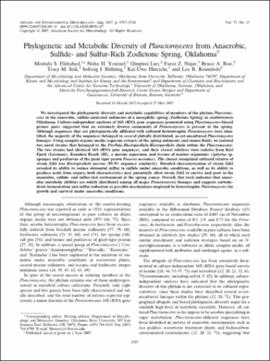| dc.contributor.author | Elshahed, Mostafa S. | |
| dc.contributor.author | Youssef, Noha H. | |
| dc.contributor.author | Luo, Qingwei | |
| dc.contributor.author | Najar, Fares Z. | |
| dc.contributor.author | Roe, Bruce A. | |
| dc.contributor.author | Sisk, Tracy M. | |
| dc.contributor.author | Buhring, Solveig I. | |
| dc.contributor.author | Hinrichs, Kai-Uwe | |
| dc.contributor.author | Krumholz, Lee R. | |
| dc.date.accessioned | 2018-08-29T14:24:36Z | |
| dc.date.available | 2018-08-29T14:24:36Z | |
| dc.date.issued | 2007-08 | |
| dc.identifier | oksd_elshahed_phylogenetican_2007 | |
| dc.identifier.citation | Elshahed, M. S., Youssef, N. H., Luo, Q., Najar, F. Z., Roe, B. A., Sisk, T. M., ... Krumholz, L. R. (2007). Phylogenetic and metabolic diversity of Planctomycetes from anaerobic, sulfide- and sulfur-rich Zodletone Spring, Oklahoma. Applied and Environmental Microbiology, 73(15), 4707-4716. https://doi.org/10.1128/AEM.00591-07 | |
| dc.identifier.uri | https://hdl.handle.net/11244/301618 | |
| dc.description.abstract | We investigated the phylogenetic diversity and metabolic capabilities of members of the phylum Planctomycetes in the anaerobic, sulfide-saturated sediments of a mesophilic spring (Zodletone Spring) in southwestern Oklahoma. Culture-independent analyses of 16S rRNA gene sequences generated using Planctomycetes-biased primer pairs suggested that an extremely diverse community of Planctomycetes is present at the spring. Although sequences that are phylogenetically affiliated with cultured heterotrophic Planctomycetes were identified, the majority of the sequences belonged to several globally distributed, as-yet-uncultured Planctomycetes lineages. Using complex organic media (aqueous extracts of the spring sediments and rumen fluid), we isolated two novel strains that belonged to the Pirellula-Rhodopirellula-Blastopirellula clade within the Planctomycetes. The two strains had identical 16S rRNA gene sequences, and their closest relatives were isolates from Kiel Fjord (Germany), Keauhou Beach (HI), a marine aquarium, and tissues of marine organisms (Aplysina sp. sponges and postlarvae of the giant tiger prawn Penaeus monodon). The closest recognized cultured relative of strain Zi62 was Blastopirellula marina (93.9% sequence similarity). Detailed characterization of strain Zi62 revealed its ability to reduce elemental sulfur to sulfide under anaerobic conditions, as well as its ability to produce acids from sugars; both characteristics may potentially allow strain Zi62 to survive and grow in the anaerobic, sulfide- and sulfur-rich environment at the spring source. Overall, this work indicates that anaerobic metabolic abilities are widely distributed among all major Planctomycetes lineages and suggests carbohydrate fermentation and sulfur reduction as possible mechanisms employed by heterotrophic Planctomycetes for growth and survival under anaerobic conditions. | |
| dc.format | application/pdf | |
| dc.language | en_US | |
| dc.publisher | American Society for Microbiology | |
| dc.rights | This material has been previously published. In the Oklahoma State University Library's institutional repository this version is made available through the open access principles and the terms of agreement/consent between the author(s) and the publisher. The permission policy on the use, reproduction or distribution of the material falls under fair use for educational, scholarship, and research purposes. Contact Digital Resources and Discovery Services at lib-dls@okstate.edu or 405-744-9161 for further information. | |
| dc.title | Phylogenetic and metabolic diversity of Planctomycetes from anaerobic, sulfide- and sulfur-rich Zodletone Spring, Oklahoma | |
| osu.filename | oksd_elshahed_phylogenetican_2007.pdf | |
| dc.description.peerreview | Peer reviewed | |
| dc.identifier.doi | 10.1128/AEM.00591-07 | |
| dc.description.department | Microbiology and Molecular Genetics | |
| dc.type.genre | Article | |
| dc.type.material | Text | |
| dc.subject.keywords | sulfur | |
| dc.subject.keywords | sulfides | |
| dc.subject.keywords | diversity | |
| dc.subject.keywords | metabolism | |
| dc.subject.keywords | phylogeny | |
| dc.subject.keywords | oklahoma | |
